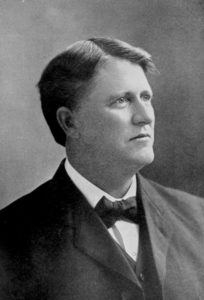John Henry Kirby was called by some the “father of industrial Texas.” He was born on a farm near Peach Tree Village in Tyler County on November 16, 1860. His mother taught him to read and write, but he had a limited formal education. Kirby studied law under state senator Samuel Bronson Cooper. In 1882 Kirby was appointed calendar clerk of the Texas Senate where he served for two years. He was admitted to the bar in 1885.
Kirby practiced law in Woodville for four years. During this time, he married Lelia Stewart. After the birth of their daughter, Bessie May, the family moved to Houston.
With some Boston associates, Kirby earned a fortune by forming The Texas and Louisiana Land and Lumber Company and the Texas Pine Land Association. These were the two largest lumber companies in east East Texas.
Kirby along with Bostonians Nathaniel D. Silsbee and Ellington Pratt built the Gulf, Beaumont, and Kansas City Railway in 1896. The group sold the railway to the Atchison, Topeka and Santa Fe Railway. At about the same time Kirby and Patrick Calhoun founded the Houston Oil Company of Texas and the Kirby Lumber Company. Both companies were involved in charges of misrepresentation resulting in lengthy litigation. At its peak of business, Kirby Lumber operated thirteen sawmills and managed more than 300,000 acres of pineland in east East Texas. In 1920, Kirby organized the Kirby Petroleum Company.
Kirby served in the Texas Legislature for two terms. In 1916 he was a delegate to the Democratic National Convention.
In 1928, Kirby built a lavish mansion at 2006 Smith Street. It had one of the city’s most beautiful gardens, containing a lake with a bucolic bridge. Since the family left the property, several different business and law offices have occupied the home.
Howard Hughes, Sr. and John Kirby were two of the first Houstonians to own an automobile.
Like many Houstonians during the Great Depression, Kirby suffered major financial loss and was forced to end control of his lumber companies and the Kirby Petroleum Company. Until his death on November 9, 1940, John Kirby continued to serve on several different lumber association boards. Kirby is buried in Forest Park Cemetery in Houston.
Kirby Drive is named after John Henry Kirby. It runs through some of Houston’s most tony neighborhoods, River Oaks and West University Place. Upper Kirby is a commercial district. Kirby Drive runs north and south. It begins at the intersection of Allen Parkway and Shepherd Drive and ends at Holmes Road south of Loop 610 and NRG Stadium.


